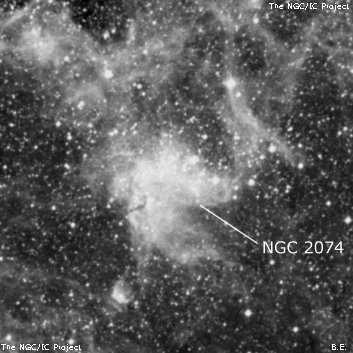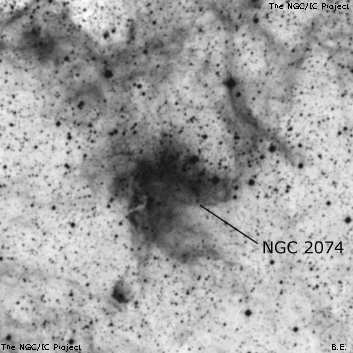NGC/IC Project Restoration Effort
(This is a very very beta version)
NGC2074


Basic Information
Location and Magnitude
Right Ascension: 5:39:3.6
Declination: -69:29:53
Constellation: DOR
Visual Magnitude:
Historic Information
Discoverer: Dunlop
Year of discovery: 1826
Discovery aperture: 9.0
Observational
Summary description: pB, pL, mE, 5 st inv
Sub-type: EN
Corwin's Notes
=====
NGC 2074. See NGC 2050 for more on the origins of the positions for eight
objects in the LMC in the area around 30 Doradus (NGC 2070), including this
one. Like NGC 2050, NGC 2074 is also outside the boundaries of the sketches
of the 30 Dor area that I've been able to locate in the Herschel Archives.
Unlike NGC 2050, however, JH's position points at a rich star cloud embedded
in a bright nebula, presumeably an HII region. JH has an added note,
"Involves 5 stars, 2 of which are 10 m." This is a relatively crowded field,
so it is not easy to tell exactly which stars JH has in mind, but there is
no doubting the identification.
Steve's Notes
=====
NGC 2074
24" (4/10/08 - Magellan Observatory, Australia): this prominent HII region (LMC-N158C) and cluster (OB-association LH 101) appeared as a very bright, very large "C" shaped nebula surrounding a semi-circular chain or crown of stars open to the SW. Two bright mag 10.4 and 11 stars oriented SW-NE (50" separation) lie on the northwest end of this crown. The northeastern luminary is a very close pair of OB-stars (TDS 3273 = 11.4/11.8 at 2") and the star at the southwest end (HD 269923) is the brightest in the cluster. On the opposite southeast end of the chain is a brighter mag 12.5 star (O3-class supergiant). A small bright knot, ~35" diameter, is superimposed on the general glow in the northeast side of the "C". At 216x at least 20 fainter stars were resolved in the chain besides the brighter stars at the ends. NGC 2074 is part of a huge complex (LMC-N158) stretching 11' SW-NE with NGC 2081, a bright HII region that lies just 8' NE. LMC-N158 is located roughly 20' SSE of the center of the Tarantula Nebula.



